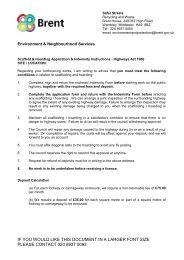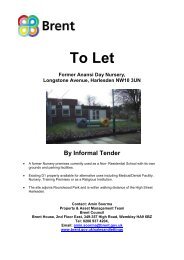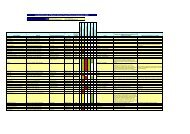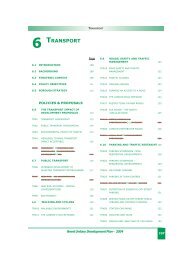Planning for Sport and Active Recreation Facilities ... - Brent Council
Planning for Sport and Active Recreation Facilities ... - Brent Council
Planning for Sport and Active Recreation Facilities ... - Brent Council
Create successful ePaper yourself
Turn your PDF publications into a flip-book with our unique Google optimized e-Paper software.
sports grounds from development, opportunities <strong>for</strong><br />
large sum s106 agreements are increasingly rare. Should<br />
there be an exceptional circumstance allowing the loss<br />
of existing sports provision, this should be adequately<br />
compensated <strong>for</strong> through a separate s106 agreement.<br />
To fund the high costs involved with sports facility<br />
improvements this will require significant contributions<br />
to be met from development. Improvements such as<br />
pitch drainage, new buildings including sports halls,<br />
pavilions <strong>and</strong> changing rooms, <strong>and</strong> purpose built facilities<br />
such as swimming pools, courts <strong>and</strong> artificial pitches can<br />
range from around £75,000- £5 million+. While these<br />
could be fully funded through development, this would<br />
rely on large or significant scale development schemes<br />
coming <strong>for</strong>ward in areas of deficiency, which can offer<br />
large lump sum payments to be spent in the general<br />
vicinity of the development. In many cases, s106 monies<br />
only partially fund these projects <strong>and</strong> require funding<br />
from other sources. In practice the number of large<br />
scale development schemes requiring s106 obligations<br />
fluctuate each year (roughly between 30-50 <strong>and</strong> probably<br />
20-30 are signed) <strong>and</strong> it is not always appropriate to<br />
prioritise monies towards sport facilities improvement in<br />
each case.<br />
In practice, as there is a limited availability of s106<br />
contributions with different services competing <strong>for</strong><br />
equally important priorities of need, not all improvement<br />
programmes can be funded by s106 obligations <strong>and</strong><br />
contributions. <strong>Sport</strong> provision is only one element<br />
of a number of pressures requiring new provision or<br />
improvement in the borough, <strong>and</strong> competes with other<br />
higher priority needs. Such dem<strong>and</strong>s include new school<br />
places <strong>and</strong> education facilities, transport improvements,<br />
new health facilities, improved public open space <strong>and</strong><br />
play facility provision, training opportunities, public art<br />
provision, public realm improvements, new community<br />
spaces etc. <strong>Sport</strong> does need to be raised high on the list<br />
of priorities due to the poor levels of provision, <strong>and</strong> low<br />
participation rates compared to London <strong>and</strong> Engl<strong>and</strong>.<br />
It should also be recognised <strong>for</strong> its health benefits <strong>and</strong><br />
contribution to crime reduction, particularly amongst<br />
adolescents.<br />
It is there<strong>for</strong>e particularly important the deficiencies<br />
<strong>for</strong> sport provision are identified in the borough <strong>and</strong><br />
recommendations <strong>for</strong> where these can be improved<br />
are disseminated to the wider network. This includes<br />
<strong>Council</strong> members, council officers in the Parks, <strong>Sport</strong>s<br />
Development, <strong>and</strong> <strong>Planning</strong> Services, <strong>Brent</strong>’s s106 officer<br />
<strong>and</strong> developers.<br />
105<br />
When development proposals do come<br />
<strong>for</strong>ward, this <strong>for</strong>ms the evidence base in which monies<br />
can be prioritised towards improving sports participation<br />
109<br />
in the Borough.<br />
Due to the nature of development, it is often difficult to<br />
predict when a large scale planning application, which<br />
could offer significant contributions towards sports<br />
improvement will be submitted or when this will be<br />
built. Although in many cases pre-application advice<br />
is given to developers, this is not always the case, <strong>and</strong><br />
there<strong>for</strong>e there is no reliability of when a development<br />
may come <strong>for</strong>ward. Also once applications are approved<br />
<strong>and</strong> s106 agreements signed, the developer has 3 years<br />
to make a start on the development. In some cases,<br />
due to any number of reasons this may not proceed, or<br />
the construction phase takes longer than 3 years. This<br />
there<strong>for</strong>e makes it difficult <strong>for</strong> the council to time the<br />
delivery of a sports facility improvement programme in<br />
line with new development.<br />
While planning gain is a useful method of delivering<br />
improved sports facility provision, there are constraints<br />
which limit its use. Negotiating on how s106 monies will<br />
be used when competing with other priority pressures,<br />
uncertainty as to how much, where <strong>and</strong> when funds will<br />
become available, <strong>and</strong> setting a time-frame in the delivery<br />
of a programme of sports improvement facilities are some<br />
of these. In many cases, particularly <strong>for</strong> more expensive<br />
improvements, s106 monies used in combination<br />
with other funding streams may be the most practical<br />
approach to delivering a sports improvement programme.








![0702012-khat[1] - Brent Council](https://img.yumpu.com/11457346/1/184x260/0702012-khat1-brent-council.jpg?quality=85)








